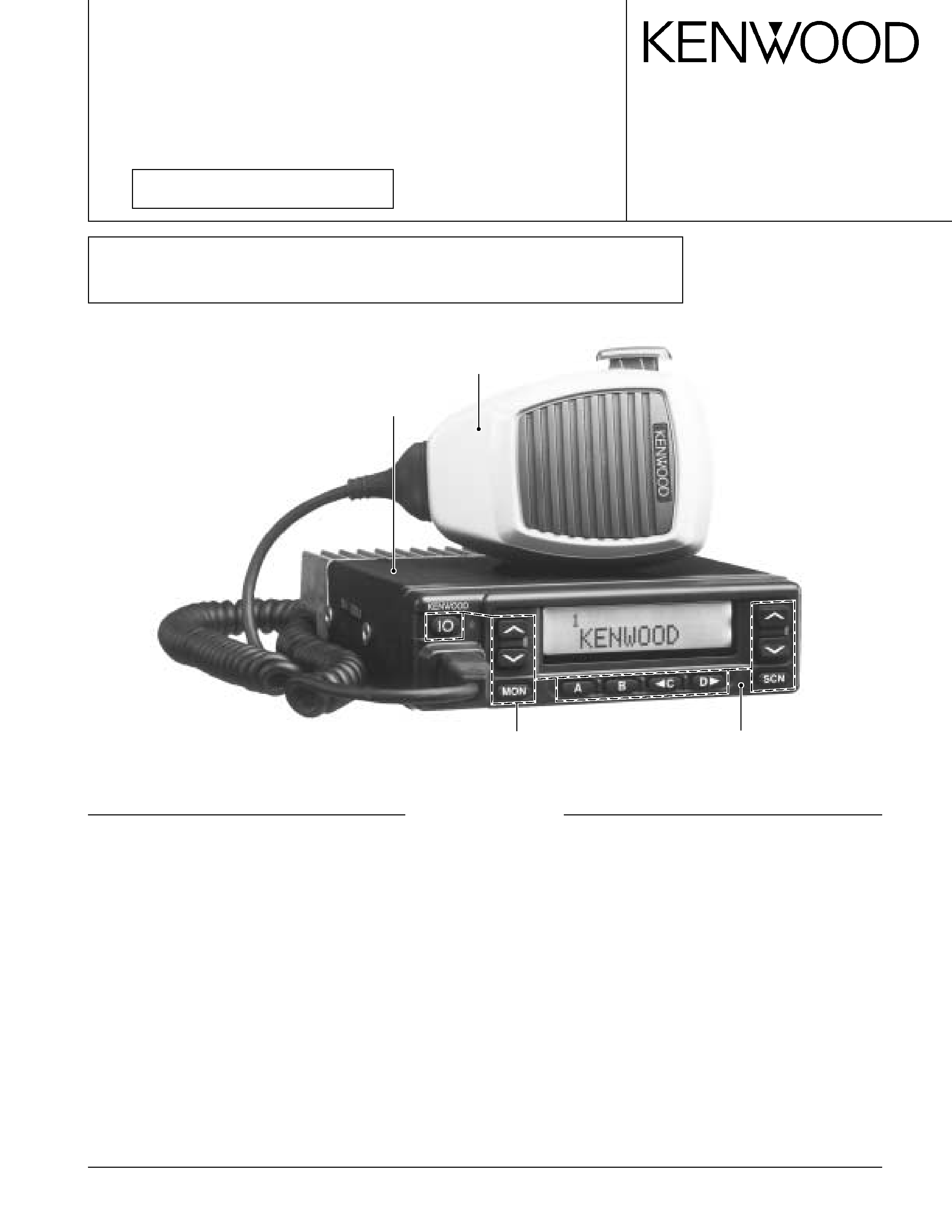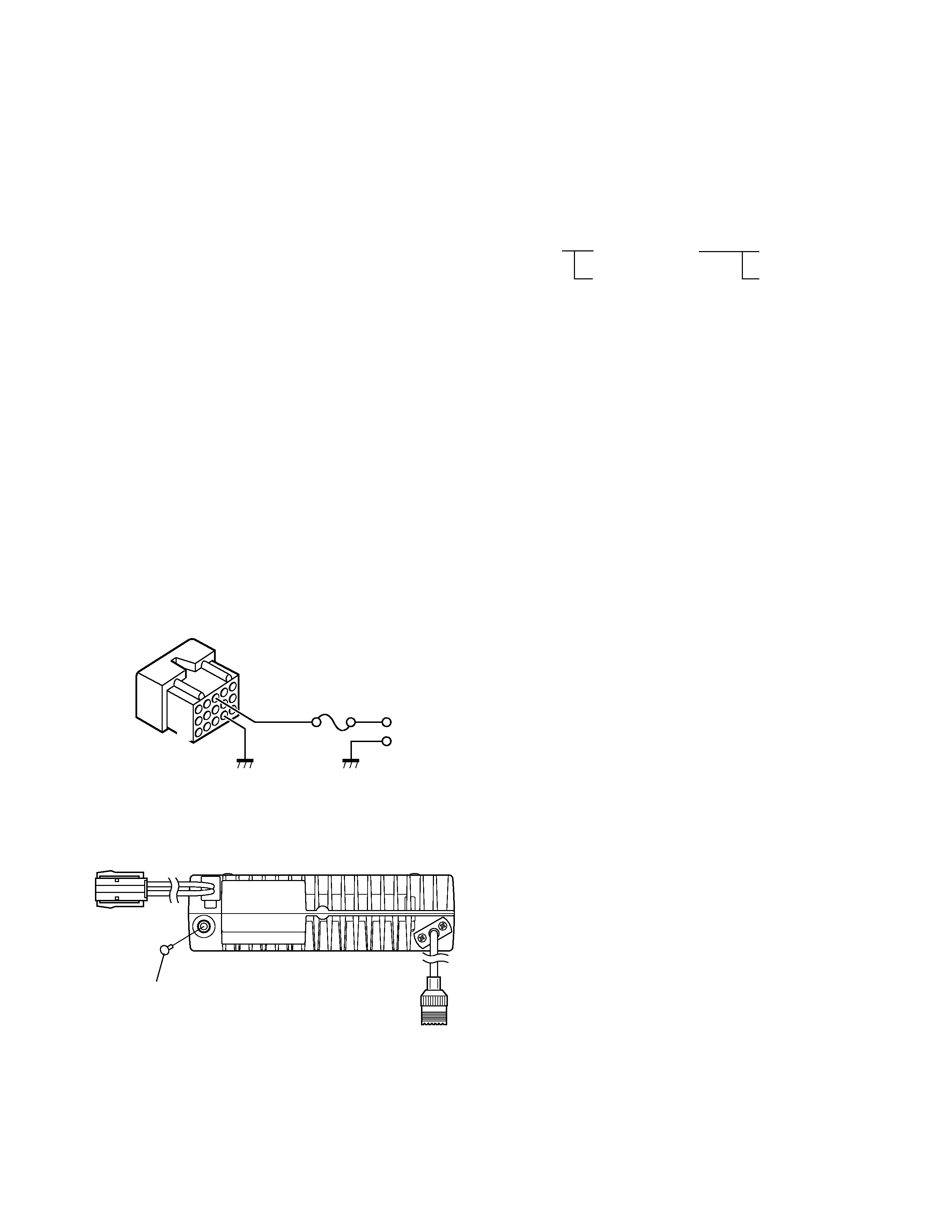
© 2001-5 PRINTED IN JAPAN
B51-8582-00 (N) 1370
UHF FM TRANSCEIVER
TK-880/H
SERVICE MANUAL
GENERAL ................................................................. 2
OPERATING FEATURES ......................................... 3
REALIGNMENT ...................................................... 15
INSTALLATION ...................................................... 20
CIRCUIT DESCRIPTION ......................................... 28
SEMICONDUCTOR DATA ..................................... 33
DESCRIPTION OF COMPONENTS ....................... 35
PARTS LIST ............................................................ 37
EXPLODED VIEW .................................................. 48
PACKING ................................................................ 49
ADJUSTMENT ....................................................... 50
PC BOARD VIEWS
PLL/VCO (X58-4550-XX) .................................. 58
TX-RX UNIT (X57-6450-XX) (A/2) ................... 59
TX-RX UNIT (X57-6450-XX) (B/2) .................... 65
SCHEMATIC DIAGRAM ........................................ 69
BLOCK DIAGRAM .................................................. 77
LEVEL DIAGRAM................................................... 80
TERMINAL FUNCTION ......................................... 82
SPECIFICATIONS................................................... 83
CONTENTS
Microphone
(T91-0621-05)
Cabinet (Top)
(A01-2165-13)
Panel assy
(A62-0991-03)
Key top
(K29-5284-02)
SUPPLEMENT
This service manual applied to products with 30200001 or subsequent serial numbers.
In terms of the products with the serial numbers earier than 30200001, refer to the TK-880/H
service manual as per part No. B51-8462-10.

2
TK-880/H
GENERAL
INTRODUCTION
SCOPE OF THIS MANUAL
This manual is intended for use by experienced techni-
cians familiar with similar types of commercial grade com-
munications equipment. It contains all required service in-
formation for the equipment and is current as of this publi-
cation date. Changes which may occur after publication are
covered by either Service Bulletins or Manual Revisions,
which are issued as required.
ORDERING REPLACEMENT PARTS
When ordering replacement parts or equipment informa-
tion, the full part identification number should be included.
This applies to all parts : components, kits, and chassis. If
the part number is not known, include the chassis or kit
number of which it is a part and a sufficient description of
the required component, for proper identification.
PERSONNEL SAFETY
The following precautions are recommended for person-
nel safety :
· DO NOT transmit if someone is within two feet (0.6
meter) of the antenna.
· DO NOT transmit until all RF connectors are secure and
any open connectors are properly terminated.
· SHUT OFF this equipment when near electrical blasting
caps or while in an explosive atmosphere.
· All equipment should be properly grounded before
power-up for safe operation.
· This equipment should be serviced by only qualified
technicians.
PRE-INSTALLATION CONSIDERNATIONS
1. UNPACKING
Unpack the radio from its shipping container and check
for accessory items. If any item is missing, please contact
KENWOOD immediately.
2. LICENSING REQUIREMENTS
Federal regulations require a station license for each ra-
dio installation (mobile or base) be obtained by the equip-
ment owner. The licensee is responsible for ensuring trans-
mitter power, frequency, and deviation are within the limits
permitted by the station license.
Transmitter adjustments may be performed only by a li-
censed technician holding an FCC first, second or general
class commercial radiotelephone operator's license. There
is no license required to install or operate the radio.
3. PRE-INSTALLATION CHECKOUT
3-1. Introduction
Each radio is adjusted and tested before shipment. How-
ever, it is recommended that receiver and transmitter op-
eration be checked for proper operation before installation.
3-2. Testing
The radio should be tested complete with all cabling and
accessories as they will be connected in the final installa-
tion. Transmitter frequency, deviation, and power output
should be checked, as should receiver sensitivity, squelch
operation, and audio output. QT equipment operation
should be verified.
4. PLANNING THE INSTALLATION
4-1. General
Inspect the vehicle and determine how and where the
radio antenna and accessories will be mounted.
Plan cable runs for protection against pinching or crush-
ing wiring, and radio installation to prevent overheating.
4-2. Antenna
The favored location for an antenna is in the center of a
large, flat conductive area, usually at the roof center. The
trunk lid is preferred, bond the trunk lid and vehicle chassis
using ground straps to ensure the lid is at chassis ground.
4-3. Radio
The universal mount bracket allows the radio to be
mounted in a variety of ways. Be sure the mounting surface
is adequate to support the radio's weight. Allow sufficient
space around the radio for air cooling. Position the radio
close enough to the vehicle operator to permit easy access
to the controls when driving.
4-4. DC Power and wiring
1. This radio may be installed in negative ground electrical
systems only. Reverse polarity will cause the cable fuse
to blow. Check the vehicle ground polarity before installa-
tion to prevent wasted time and effort.
2. You must connect the positive power lead directly to
the positive terminal of the vehicle battery. Never
connect the lead to any other positive power source,
such as a cigarette lighter jack or fuse terminals.
CAUTION
If DC power is to be controlled by the vehicle ignition
switch, a switching relay should be used to switch the posi-
tive power lead. The vehicle ignition switch then controls
DC to the relay coil.
3. You must also connect the ground lead directly to
the negative terminal of the vehicle battery.
4. The cable provided with the radio is sufficient to handle
the maximum radio current demand. If the cable must be
extended, be sure the additional wire is sufficient for the
current to be carried and length of the added lead.

3
TK-880/H
5. INSTALLATION PLANNING CONTROL STATIONS
5-1. Antenna system
Control station. The antenna system selection depends
on many factors and is beyond the scope of this manual.
Your KENWOOD dealer can help you select an antenna sys-
tem that will best serve your particular needs.
5-2. Radio location
Select a convenient location for your control station radio
which is as close as practical to the antenna cable entry
point. Secondly, use your system's power supply (which
supplies the voltage and current required for your system).
Make sure sufficient air can flow around the radio and power
supply to allow adequate cooling.
SERVICE
This radio is designed for easy servicing. Refer to the
schematic diagrams, printed circuit board views, and align-
ment procedures contained in this manual.
Note
When you modify your radio as described in system set-
up, take the following precaution.
The rating of pin 7 (SB) of the accessory connector cable
(KCT-19) on the rear of the radio is 13.6V (1A). Insert a 1A
fuse if you use the SB pin for external equipment.
Accessory connector
cable (KCT-19)
If you do not intend to use the 3.5-mm jack for the exter-
nal speaker, fit the supplied speaker-jack cap (B09-0235-05)
to stop dust and sand getting in.
GENERAL / OPERATING FEATURES
Speaker-jack cap
(B09-0235-05)
1. Operation Features
The TK-880/880H is a UHF FM radio designed to operate
in both trunking format (LTR model) and conventional for-
mat (Conventional model). The programmable features are
summarized.
Model
Trunking format
Trunking mode
Conventional format
Conventional mode
1-1. Trunking Format
This format can handle up to 32 systems with up to 250
groups in each system. The transceiver can be used in both
trunked mode and conventional mode. Systems, groups,
and their functions are programmed.
1-2. Conventional Format
This format can handle up to 250 groups with 250 chan-
nels in each group. The transceiver can be used only in con-
ventional mode. Groups, channels, and their functions are
programmed.
2. Transceiver Controls and Indicators (Fig. 1)
2-1. Front Panel Controls
All the keys on the front panel are momentary-type push
buttons. The functions of these keys are explained below.
· POWER key
Transceiver POWER key. When the power is switched
off, all the parameters, such as the system and group in
trunking format, and the group and channel in conventional
format, are stored in memory. When the power is switched
on again, the transceiver returns to the previous conditions.
· SYSTEM UP/DOWN key
(Trunking format, programmable)
· GROUP UP/DOWN key
(Conventional format, programmable)
· SCAN key (Programmable)
· MONITOR key (Programmable)
· A, B, C and D key (Programmable)
· VOLUME UP/DOWN key (Programmable)
· BUSY/TX LED
The BUSY indicator (Green LED) shows that the channel
is in use. The TX indicator (Red LED) shows that you are
transmitting.
1
3
+
7
6
13
15

4
TK-880/H
2-2. Programmable Keys
The FPU (KPG-49D) enables programmable keys to se-
lect the following functions.
s Conventional format
AUX-A, AUX-B (Only when voice scrambler is not se-
lected), Channel down, Channel up, DTMF ID (BOT), DTMF
ID (EOT), Display character, Emergency (Only foot key),
Function, Group down, Group up, Home channel, Horn alert,
Key lock, Memory (RCL/STO), Memory (RCL), Memory
(STO), Monitor A, Monitor B, Monitor C, Monitor D, Opera-
tor selectable tone, Public address, Redial, Scan, Scan del/
add, Scrambler (Only when voice scrambler is selected),
Talk around, Volume down, Volume up and None.
s Trunking format
Auto tel, AUX-A, AUX-B (Only when voice scrambler is
not selected), DTMF ID (BOT), DTMF ID (EOT), Display char-
acter, Emergency (Only foot key), Function, Group down,
Group up, Home group, Horn alert, Key lock, Memory (RCL/
STO), Memory (RCL), Memory (STO), Monitor A, Monitor B,
Monitor C, Monitor D, Public address, Redial, Scan, Scan
del/add, Scan temporary delete, Scrambler (Only when
voice scrambler is selected), System down, System up, TEL
disconnect, Volume down, Volume up and None.
These functions the FPU programs to the function keys
and described in the following sections.
· Auto TEL (Trunking format)
Automatically connects available repeaters that are con-
nected to telephone circuits when operating as LTR system.
The time allocated to search for available repeaters is 60
seconds, after which connection failure occurs, a DTMF
tone is output and the function terminates.
If connection to an available circuit is made, only ID 253,
EOT or hang-up time-out can terminate the function.
· AUX-A
If this key is pressed, "AUX" icon lights on the LCD and
AUX port which is inside of the transceiver turns to the high
level. If pressed again, the "AUX" icon goes off and the
AUX ports turns to the lower level.
· AUX-B
This function can be programmed when the voice scram-
bler board is not installed.
If this key is pressed, an underscore ("_") appears at the
extreme right of the LCD and AUX port which is inside of the
transceiver turns to the active level. If pressed again, the
underscore disappears and the AUX ports turns to the
deactive level.
· Channel up/down (Conventional format)
When the key is pressed each time, the channel number
to be selected is incremented/decremented and repeats if
held for one second or longer. This key works as the voice
scrambler code selector in the voice scrambler code select
mode.
OPERATING FEATURES
· DTMF ID (BOT)
In conventional mode, if you press this key, a predeter-
mined DTMF ID (Begin of TX) will be sent automatically.
· DTMF ID (EOT)
In conventional mode, if you press this key, a predeter-
mined DTMF ID (End of TX) will be sent automatically.
· Display character
This key switches the LCD display between the system
and group number in trunking format and the group and
channel name in conventional format.
· Emergency
Pressing this key for longer than the programmed "Emer-
gency Key Delay Time" causes the transceiver to enter the
emergency mode. The transceiver jumps to the pro-
grammed "Emergency system and group in trunking format
and the group and channel in conventional format" and
transmits for the programmed "Active Time".
The transceiver disables mic mute while transmitting.
After finishing transmission, the transceiver receivers for
the programmed "Interval Time". The transceiver mutes
the speaker while receiving. Following the above sequence,
the transceiver continues to transmit and receive.
· Function
Pressing this key causes the transceiver to display
"FCN". Then, pressing a microphone DTMF key causes the
corresponding programmed function to start. This key may
be convenient when using many functions with the micro-
phone 12-key keypad.
· Group up/down
When the key is pressed each time, the group number to
be selected is incremented/decremented and repeats if held
for one second or longer.
· Home channel (Conventional format)
Press this key once, the channel switches to the pre-pro-
grammed home channel.
· Home group (Trunking format)
Each pressing of the key selects a preset system/group.
· Horn alert
If you are called from the base station using 2-tone/DTMF
while you are away from your transceiver, you will be
alerted by the vehicle horn or some other type of external
alert. To turn the horn alert function on , press this key. A
confirmation tone sounds, and the display shows "HA" on
the sub LCD.
If this key is pressed again, the horn alert function is
turned off.
· Key lock
Pressing this key causes the transceiver to accept entry
of only the [Function], [Key lock], [PTT], [Monitor A], [Moni-
tor B], [Monitor C], [Monitor D], and [Emergency] keys.

5
TK-880/H
· Message mode
Press this key to enter the message mode. (See "Alpha-
numeric Two-way Paging Function" for details)
· Memory
This key allows DTMF memory data to be recalled; up to
32 memories each with a memory dial of up to 16 digits and
an A/N of up to 10 digits per memory.
· Monitor
Used to release signalling or squelch when operating as a
conventional. It is also used to reset option signalling.
· Operator selectable tone (Conventional format)
This key switches the pre-set decode QT/DQT and en-
code QT/DQT to OST (Operator Selectable Tone) tone pair.
Press this key, the transceiver enters to OST select
mode. In this mode, the display shows "OFF" and the op-
erator can select one of the OST tone pair using the group
up/down key. The display shows "TONE
**" and tone
pair No.
** is selected.
Press OST key again, the transceiver exits from the OST
select mode, and returns to the group/channel mode with
the handset indicator ( ). The handset indicator ( ) means
that the OST tone pair is selected. OST tone pair number or
OFF can be memorized for each channel.
16 kinds of tone pair for OST can be programmed by
KPG-49D. OST is useful to access the repeater with same
radio frequency and different tone (QT/DQT).
· Public address
Public address amplifies the microphone audio, and out-
puts it through a PA speaker. PA is activated by pressing
this key. A confirmation tone sounds, and the display shows
"PUBLIC ADRS". PA can be activated at anytime (scanning
or non-scanning).
The RADIO continues to scan & receive calls while in PA
mode. Pressing PTT activates PA, and will override an in-
coming call at anytime; however, no RADIO transmission
takes place.
If this key is pressed again, a confirmation tone will
sound, the display will return to the normal channel or SCAN
display, and the PA function will turn off.
· Redial
If you press this key when the system/group (Trunking
format) or group/channel (Conventional format) is displayed,
the last transmitted DTMF code will appear on the display.
Pressing the PTT switch at this time will transmit the dis-
played DTMF code.
· Scan
Press this key starts scanning. Pressing this key stops
scanning.
· Scan del/add
1) Trunking format
Used to select whether system scan routines are used
during system scan. Each pressing of the key (to ON)
toggles between lockout and lock. The scan routine is
started when on lock. The DEL indicator flashes when the
system is on lockout.
2) Conventional format
This key switches the currently displayed channel be-
tween "Delete" and "Add".
The "Add" channel contained in the scan sequence, and
"Delete" channel is not contained. In the scan mode, this
key switches the channnel delete or add temporarily.
· Scan temporary delete (Trunking format)
This key is temporarily deleted a system being scanned.
If you press this key when scan is stopped (when a call is
being received from another station), the system is tempo-
rarily deleted and scanning restarts.
This key operates even when "Scan Type" is set to "List
Type System Scan".
· Scrambler
If a scrambler code (1 to 16) has been set in the FPU, an
underscore ("_") appears at the extreme right of the LCD
display when scrambler is active. Pressing this key changes
on/off of scramble operation. Press this key for 2 seconds
to enter scrambler code selection mode.
· Send GPS (Optional)
Pressing this key causes the transceiver to send a single
GPS data. (GPS receiver must be installed.)
· System up/down (Trunking format)
When the key is pressed each time, the system number
to be selected is incremented/decremented and repeats if
held for one second or longer.
· Talk around (Conventional format)
Press this key, the transceiver uses the receive fre-
quency and the tone for transmission.
The operator can call the other party directory (without
repeater). Press this key again, the talk around function
goes off.
· Telephone disconnect (Trunking format)
Pressing this key ends an RIC connection (disconnects
the telephone line).
· Volume up/down
When the key is pressed, the volume level is increased/
decreased and repeats if held for 200ms or longer.
· None
Sounds error operation beep, and no action will occur.
Use this function when the transceiver is required to be
more simple operated.
OPERATING FEATURES
